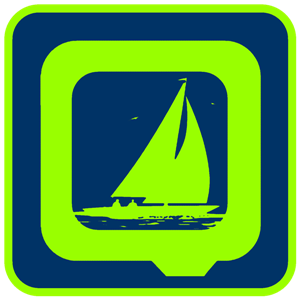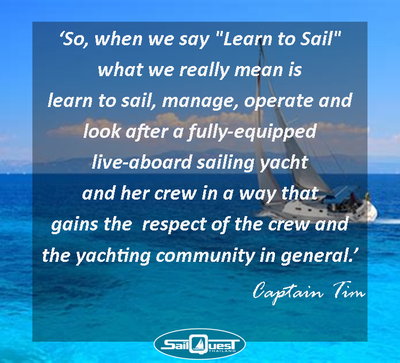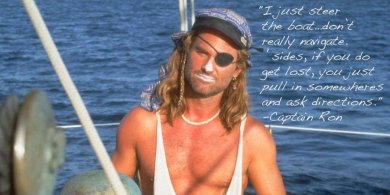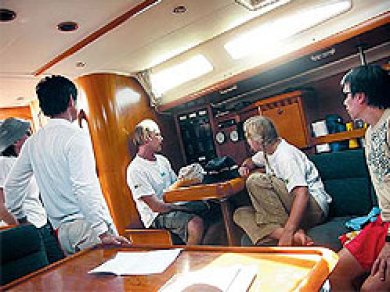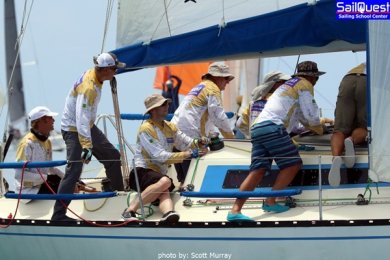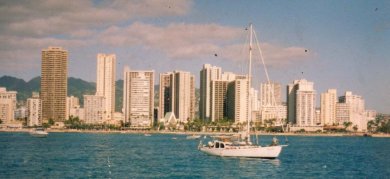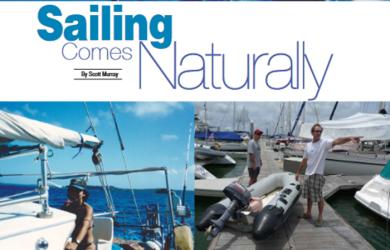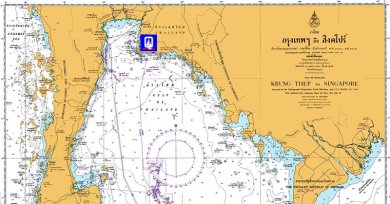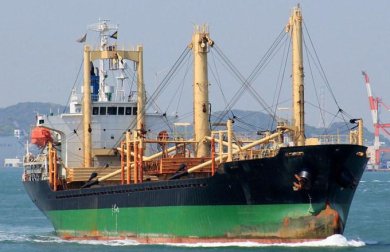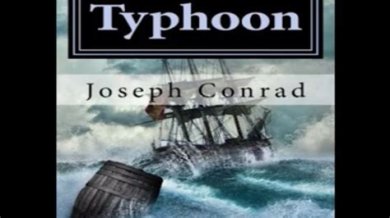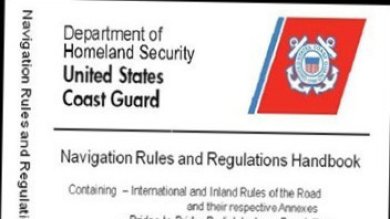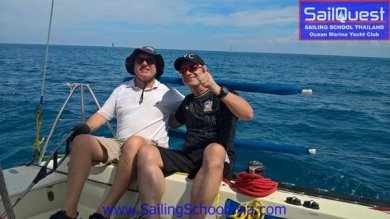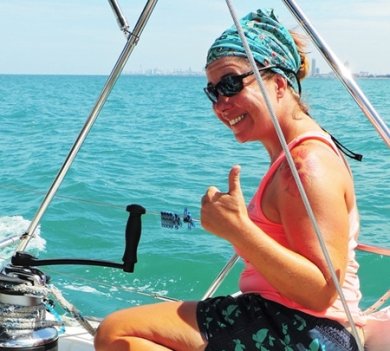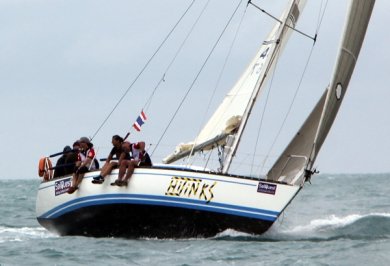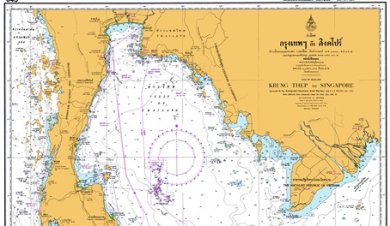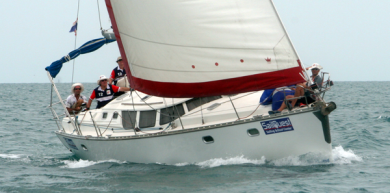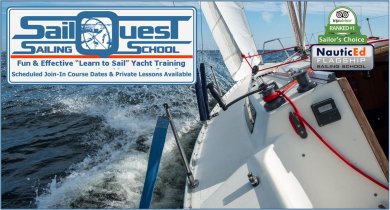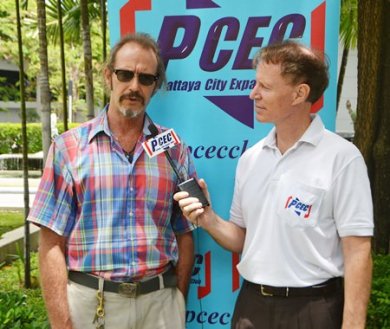Seven Years in the Pacific
By Scott Murray
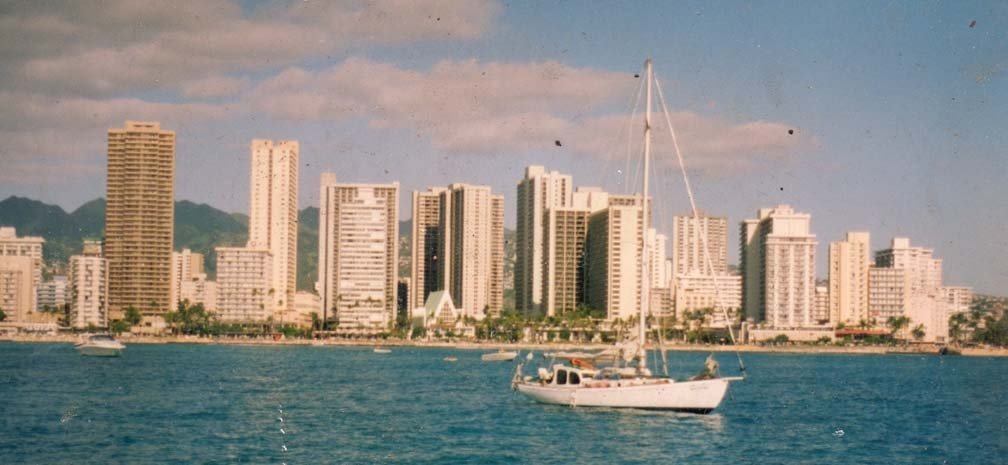
Houhere at anchor, Waikiki Beach, Honolulu Hawaii
- Tim McMahon and his partner Naomi headed off from Hawaii in June of 95 aboard Houhere, a 65-year-old leaky timber boat they spent
two years restoring. Their plan was to circumnavigate the world in two years. They had a send-off party for 100 people and one friend
even brought a miniature cannon to blast in
honour of their departure. The couple had
been in Hawaii for seven years, so they knew
lots of people and there was a good chance that
they wouldn’t see many of them again (btw - if
the pumps ever stopped working, Houhere
would have sank in a day, so in the next seven
years of cruising Tim and Naomi never left the
boat for more than 24 hours at a time). 
- Naomi making sail covers.
Their first stop was Samoa, 2100 miles
south southwest of Honolulu. As Tim recalls:
“When you sail that direction from Hawaii
during that time of the year, you are pretty
much sailing dead downwind in about 20-30
knots of wind. A couple hours out, we realized
we were never going back to Hawaii, the wind
was up, the seas were up, and we would have
pretty much had to circumnavigate the world
to get back to Hawaii. We spent the next three
days puking our guts out and feeling very low, it
was definitely a low point in our trip. Reality
had hit home. As Tim recalls, “it was all good
fun, sitting around a marina, talking up a
storm, making plans, buying provisions but
three days south of Hawaii, with Samoa 1900
miles away, is a very lonely spot on the planet in
a leaky old wooden boat, let me tell you.”
They learned a lot in that first leg, which
incidentally didn’t end in Samoa, but 1,000
miles before Samoa, when Tim realized they
were within 100 miles of Palmyra Atoll, one of
the few privately owned islands in the Pacific. It
wasn’t a scheduled stop, but Tim decided to
change course as he knew Roger, the caretaker
of the Atoll, - they had shared a boat berth in
the Ala Wai Marina in the heart of Honolulu -
and to this day he is glad he made the stop as
Palmyra is still one of his favorite spots on the
planet, lying approximately 1,100 nautical
miles southward of Honolulu. They had
covered that distance in 9 days, 2 hours.
Roger’s job was to prevent visiting yachties
from settling on Palmyra, which was a paradise
on earth (ironically, years later, Roger ended up
buying a Harley and settling in Thailand).
Tim & daughter Jeni at the wheel, today. 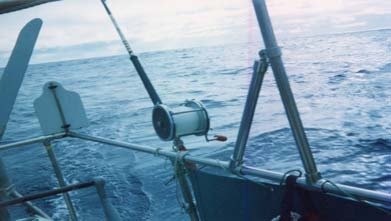
The ever present fishing pole.- “Never seen fish like it,” says Tim reminiscing
of the Atoll as he often does. “And the
snorkeling– there was no legal commercial
fishing in Palmyra – it was pristine. The marine
life was astounding, the coral heads, the
sharks. I’ve spent the rest of my life looking for
other Palmyra Atolls – it’s the picture of
paradise.
“We spent about three weeks there,
and learned a lot about the cruising life. It was a
great first stop. I’m glad it wasn’t Samoa
because my outlook would have been different.
Palmyra got me interested in more out-of-theway places, I’d done a lot of deliveries and
sailing around the Pacific, but there’s something different about sailing for money
compared to sailing for yourself, and the latter
is definitely more enjoyable as you can make
your decisions about where you want to go and
create your own time schedule.
“We got slapped around on that first
leg. We had had lots of little problems like
chafing in the wind vane, so we spent time
fixing these things and getting better prepared
for the next leg. When we pushed off from
Hawaii, I don’t think we were really ready to go
– I don’t think anyone who goes cruising is ever
really ready to go – but you come to a point
where you just have to push off, otherwise you
just sit there on the beach buying more stuff,
and hearing more ‘bad news’ stories from
people. You must realize you will never be
100% ready to go. You get to a point where your
list is pretty much taken care of and you say
‘right, we will take care of the rest of it when we
get to the next port’”
“So when we pushed off from Palmyra,
we were much better prepared than we were
when we left Hawaii even though we hadn’t
bought any new gear because obviously in
Palmyra there was nothing to buy and nowhere
to buy it. Most of our supplies also disappeared because whenever you pull into a remote harbor you are also going to have
‘instant friends’, everyone jumps into their
dinghy and motors over and says ‘How’s it
going?’ ‘Where are you coming from?’ They
don’t really care about that,” Tim laughs, “they
just want a beer, because you can’t buy alcohol
and other goodies in those remote anchorages.
“So lesson learned - whenever you pull
into a remote anchorage like Palmyra, Chagos - Christmas Island or Fanning Atoll, don’t
shout ‘Come on over for a beer’, because every
man and their dog is going to come on over for a
beer and there goes the ships stores. Of course,
I have been on both sides of that situation!” 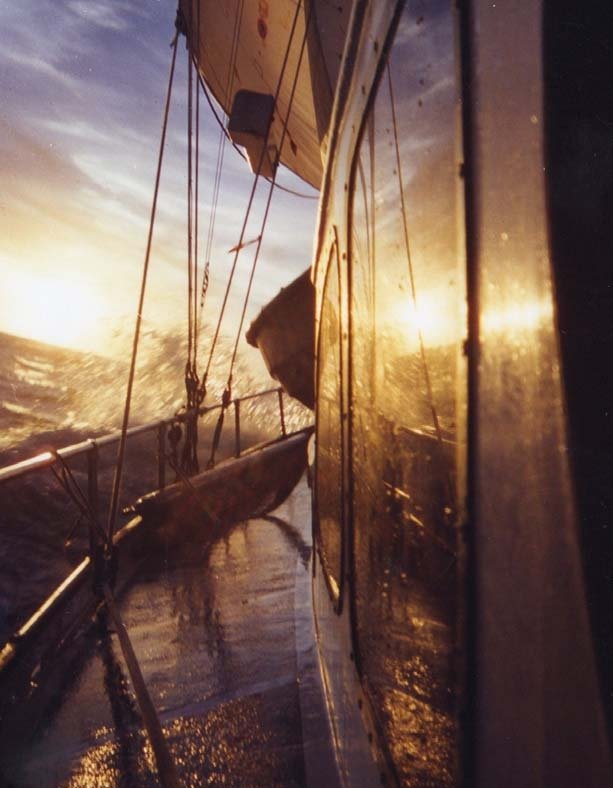
From Palmyra, the McMahons headed
for Samoa with Chad, their new-found useless
crewmate who had been stranded on Palmyra
Atoll and needed a lift. “I’ve never had a worse
crew member,” Tim says. “He would never get
out of his bunk, he wasn’t sick, he just didn’t
want to move, except for mealtimes and
occasionally to holler ‘ARRR’ from the bow of
the boat. But Roger asked me to take him along
so I felt obligated.”
It’s about 1,500 miles from Palmyra to
Pago, Pago, in America Samoa, and they made
this passage in 10 days and 6 hours. When
Houhere hit Samoa, Chad was quickly
dispatched, though he did have the gall to
come back three days later and ask Tim for a
reference. The McMahons later hit Apia in
Western Samoa and stayed in Samoa for about
a month. Since there’s not a lot of land in the
Pacific, many yachties were moored in Samoa
and they were committed to their dream (“If
you’re in Samoa, you’re cruising,” Tim says.).
“The cruisers weren’t who you thought
they’d be either: they were little old ladies,
nerds who have never been on a boat before,
Mr and Mrs Jones who decided to push off
and were learning along the way. They had all
dropped what they were doing and had
committed their lives to sailing. Many people
have the boat and have the dream, but they
don’t do it. When you actually get out there in
the cruising grounds of the Pacific (Tonga, Fiji,
Micronesia, and the Philippines) you meet a
lovely and interesting group of people. That’s
when our two-year carefully planned circumnavigation turned into a sailing lifestyle with no foreseeable ending or obvious outcome. I have been living that way ever since.”
- A cruising family – the Kavenga crew.
Tim’s years of charter experience also
proved invaluable as where ever they went his
knowledge was called upon to help fix one
problem or another with fellow yachties’ boats.
The McMahons, at 30, were also some of the
youngest yachties cruising.
“When you come into any popular
port in the Pacific whether it be Suva in Fiji or
Neiafu in Tonga or the like, you meet an
amazing cross-section of people: there’s the
guys who are coming in and leaving tomorrow,
the cruising families that are there to look
around the island, some guy who ran aground
and is repairing his boat on the beach, and
then there’s people who have been in the
harbor living on their boat for a decade. I fell in
love with that group of people and that lifestyle.
The sailing is a part of it for sure, but the
community is a big part of what makes cruising
interesting for me (there hadn’t been much of a
community feeling during Tim’s deliveries in
the North Pacific, routes from Hawaii to
California or on trips to Guam and Johnson
Atoll). “It’s definitely what I miss most about
cruising, the people that are out there doing it; I
don’t miss some of the miserable moments on
the boat (and there have certainly been a few of
them). Actually, when you are out there
cruising, most of your time is not spent sailing,
but in port. By the time we were about to set sail
for Tonga, we were only at sea for 20 days, but
we had left Hawaii more than 4 months earlier.
“In Samoa, I determined that when
traveling to exotic and faraway places, it’s not
necessary to see much of them, other than the
view from your boat and the nearest bar.
Naomi would go shopping and do the
sightseeing thing. I just don’t consider myself a
tourist or a sightseer, the destination is not
important to me, it’s the act of getting there.
And once the anchor feels the bottom, I’m
basically there, I don’t need to get out and
climb around, or go to the beach. So if you ask
me anything about Samoa, all I can tell you is
where to get a hamburger or where the pub
closest to the marina is – and that pretty much
sums up the information I gathered at all the
destinations we hit. (In Thailand, the farthest
inland I have been in 10 years is Bangkok, and
that’s only because a river leads into it.).”
- Mary on Sofo
Mary, aged approximately 55, was one
of accidental sailors the McMahons met. She
had worked for 7-Eleven in California, and put
her son through college. As a graduation gift
she bought him a 22ft Falmouth cutter (a trailer
sailor). The two sailed to Mexico where her son
declared sailing wasn’t for him and headed
back to California. Mary decided to carry on
and it took her two months to reach Samoa
where the McMahons first bumped into her in
tears and almost ready to eat her cat. She
eventually circumnavigated the world but kept
running into one misfortune after another with
Tim catching up – and helping her – in the
midst of many of her crises.
The massive amount of plastic sewage
and the smell from the Starkist factory had put
Tim off Samoa, or at least Pago, Pago. The next
passage,from Samoa to the middle Tongan
island group, Va’vau, was about 500 nautical
miles; it took Houhere about a week in light
winds. On a good day Houhere could sail 120
nautical miles, though one day she did do 180
from Palmyra to Samoa, which was when Tim
was carrying the useless Chad whom he
couldn’t wait to jettison in Samoa. That
experience so embittered Tim that he never
again took on crew for a long sail aboard
Houhere.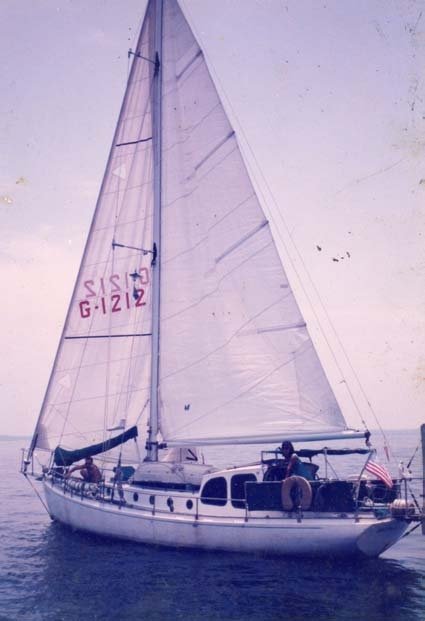
- s/y Houhere built in Aukland, NZ, 1939
By the time, the McMahons had left
Samoa, they had started to relax and really get
into the cruising lifestyle. They began to realize
that they didn’t need to race around the world.
They had also become adept fishermen and
made it a point to give some local catch along
with a can of beer to every immigration and
customs official they visited, a foolproof
technique to grease the wheels and pave the
way for trouble-free port clearance formalities.
When they hit Tonga, they headed for
Neiafu, the main anchorage in the middle
group. Tonga was meant to be a pit stop on
their journey, but they hadn’t realized it was
such significant and interesting cruising
ground. Sunsail had a base there, so they got
their hands on Sunsail’s cruising guide and
went about exploring Tonga’s 33 anchorages.
This became the start of the “molested boat”
tour where locals tried to sell them anything
and everything. They spent a few months in
Tonga before heading over to Fiji, covering the
700 mile passage in just under 6 days of
cruising bliss.
They made a tricky night entry into
Suva, the South Pacific’s biggest city. It was
another big holding tank for cruising sailors with about 150 yachts anchored up in the bay. There was
a great sailor’s bar, which was a wealth of information. The
couple stayed in the Fiji island group for about 6 months.
Then, from the Yasawa Group they then sailed to
Funafuti (Kirabati), on to Tarawa, Kosarae, Pohnepe ,
Truk and then Saipan. The irony was that McMahon, an
American, was basically covering the Japanese retreat from
World War II with his Japanese wife.
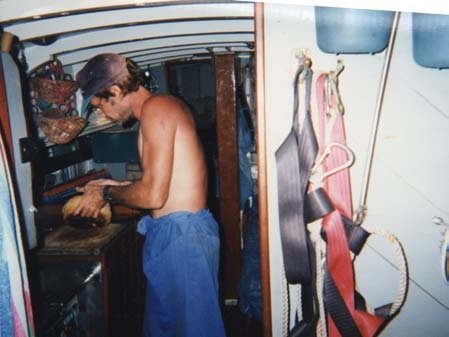 Tim on Houhere
Tim on Houhere
While in Honolulu, the McMahons had met a
Japanese couple named Yoko and Kubosan who lived on
Saipan, and they had offered the McMahons their home
and vehicle if they ever made it to Saipan. Tim had helped
them fix their Hunter 43 yacht they were delivering it from
California to Saipan. When Tim and Naomi sailed into
Saipan’s Smiling Cove marina, Yoko and Kubo met them
on the dock with pizza and ice cream. Within a day,
Naomi had a job at Duty Free Shoppers and Tim, using
his US captain’s license, was quickly able to snag a job
driving a charter sport fishing boat doing daytrips and
working as a stand by captain for one of the islands dinner
cruise operators in the evenings. Although he is shy to
admit it, he also worked on a few occasions as a speed boat
skipper with a banana boat in tow, taking tourists on
daytrips around the islands lagoon. They stayed in Saipan
for a year.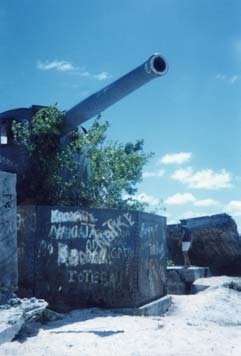
- WW2 left-overs on Tarawa
When they resumed their journey, they headed to
Japan via the Bonin Islands, Iwo Jima and Chichi Jima,
before crossing over to Okinawa, leaving Houhere in the
port while they went to visit Naomi’s family and tour
around mainland Japan for a while. During the month
long voyage from Saipan to Japan they logged over 1800
wet and wild sea miles. Then they returned to Saipan,
took care of some needed maintenance issues before
heading off for the Philippines, dropping the hook in the
small bay of Rapu Rapu before passing through the San
Bernardino Strait. That crossing trip took 10 days, 2 hours
on a 1,500 mile sleigh ride: dead downwind all the way
with 30 knots of wind on the tail. After clearing the outer
channel marks leaving Saipan, Tim didn’t touch the
wheel for 10 days. They ended up spending a couple
months in the Manila Yacht Club and almost a year in the
Philippines.
The McMahons entered Manila Bay at midnight;
as they turned the corner into the Bay Tim said he had
never seen so many boats in his life. “You could have
walked across the bay stepping from boat to boat, and I
use the word ‘boat’ loosely. Anything that floats was out
there,” Tim says. “We spent the whole night weaving
Wbetween these boats. It was like sailing through a city.”
After Manila they hit Subic, Palawan (visiting the Ad
world’s largest underwater river), Nida and Balabac
and many other fascinating locations.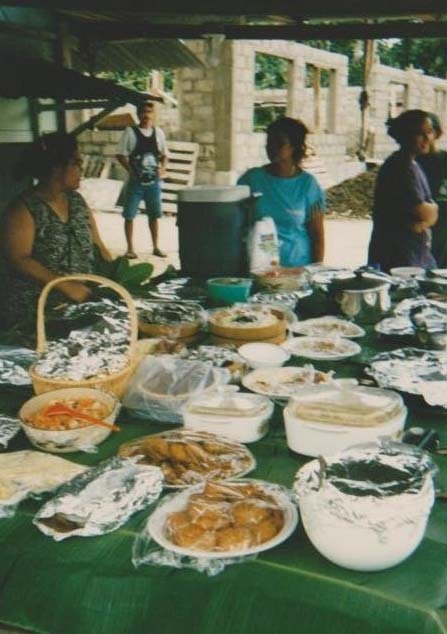
The first port of call in Malaysia was Labuan,
400 miles and about 7 days of slow passage making
from the south end of Palawan. Thirteen miles from
Labuan lay Brunei, and Tim spent a lot of time
bouncing back and forth and hanging out at the Royal
Brunei Yacht Club. The couple spent four months in
the region (Tim broke his wrist rollerblading at an
amusement park but that’s a whole other story), visiting
Miri and Bintalu and even one time going 150 miles up
a river where all they saw was Dayak Indians wearing
war paint, carrying spears and possibly sporting
shrunken heads on their leather waistbands. It’s about
a 850-mile cruise from Labuan to Singapore, and they
stopped at a number of oil-field ports and other remote
villages, as well as Kuching, where their boat became a
tourist attraction.
After leaving Singapore the couple made their
way up Malaysia’s west coast where eventually Koh Phi
Phi was their first port of call in Thailand. Tim and
Naomi’s partnership came to an end when they
reached Thailand. Oddly enough, Tim never had any
charts for the waters beyond Thailand and he figures
his settling here was just meant to be. He eventually
made it to Ao Chalong, which he called home until
And now he has set off once again on another adventure, this time running his own sailing company, SailQuest out of Ocean Marina.

.png)
